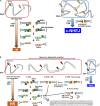Clustered DNA double-strand break formation and the repair pathway following heavy-ion irradiation
- PMID: 30476166
- PMCID: PMC6373698
- DOI: 10.1093/jrr/rry096
Clustered DNA double-strand break formation and the repair pathway following heavy-ion irradiation
Abstract
Photons, such as X- or γ-rays, induce DNA damage (distributed throughout the nucleus) as a result of low-density energy deposition. In contrast, particle irradiation with high linear energy transfer (LET) deposits high-density energy along the particle track. High-LET heavy-ion irradiation generates a greater number and more complex critical chromosomal aberrations, such as dicentrics and translocations, compared with X-ray or γ irradiation. In addition, the formation of >1000 bp deletions, which is rarely observed after X-ray irradiation, has been identified following high-LET heavy-ion irradiation. Previously, these chromosomal aberrations have been thought to be the result of misrepair of complex DNA lesions, defined as DNA damage through DNA double-strand breaks (DSBs) and single-strand breaks as well as base damage within 1-2 helical turns (<3-4 nm). However, because the scale of complex DNA lesions is less than a few nanometers, the large-scale chromosomal aberrations at a micrometer level cannot be simply explained by complex DNA lesions. Recently, we have demonstrated the existence of clustered DSBs along the particle track through the use of super-resolution microscopy. Furthermore, we have visualized high-level and frequent formation of DSBs at the chromosomal boundary following high-LET heavy-ion irradiation. In this review, we summarize the latest findings regarding the hallmarks of DNA damage structure and the repair pathway following heavy-ion irradiation. Furthermore, we discuss the mechanism through which high-LET heavy-ion irradiation may induce dicentrics, translocations and large deletions.
Figures






Similar articles
-
Nanoscale analysis of clustered DNA damage after high-LET irradiation by quantitative electron microscopy--the heavy burden to repair.DNA Repair (Amst). 2015 Apr;28:93-106. doi: 10.1016/j.dnarep.2015.01.007. Epub 2015 Jan 28. DNA Repair (Amst). 2015. PMID: 25659339
-
Carbon ion radiation and clustered DNA double-strand breaks.Enzymes. 2022;51:117-130. doi: 10.1016/bs.enz.2022.08.008. Epub 2022 Sep 27. Enzymes. 2022. PMID: 36336405
-
3D-structured illumination microscopy reveals clustered DNA double-strand break formation in widespread γH2AX foci after high LET heavy-ion particle radiation.Oncotarget. 2017 Nov 25;8(65):109370-109381. doi: 10.18632/oncotarget.22679. eCollection 2017 Dec 12. Oncotarget. 2017. PMID: 29312614 Free PMC article.
-
Repair of DNA damage induced by accelerated heavy ions--a mini review.Int J Cancer. 2012 Mar 1;130(5):991-1000. doi: 10.1002/ijc.26445. Epub 2011 Oct 23. Int J Cancer. 2012. PMID: 21935920 Review.
-
Radiation-induced clustered DNA lesions: Repair and mutagenesis.Free Radic Biol Med. 2017 Jun;107:125-135. doi: 10.1016/j.freeradbiomed.2016.12.008. Epub 2016 Dec 8. Free Radic Biol Med. 2017. PMID: 27939934 Review.
Cited by
-
Basic and translational research on carbon-ion radiobiology.Am J Cancer Res. 2023 Jan 15;13(1):1-24. eCollection 2023. Am J Cancer Res. 2023. PMID: 36777517 Free PMC article. Review.
-
High-LET-Radiation-Induced Persistent DNA Damage Response Signaling and Gastrointestinal Cancer Development.Curr Oncol. 2023 Jun 7;30(6):5497-5514. doi: 10.3390/curroncol30060416. Curr Oncol. 2023. PMID: 37366899 Free PMC article. Review.
-
Multiple radiations and its effect on biological system - a review on in vitro and in vivo mechanisms.Ann Med. 2025 Dec;57(1):2486595. doi: 10.1080/07853890.2025.2486595. Epub 2025 Apr 12. Ann Med. 2025. PMID: 40219761 Free PMC article. Review.
-
Comparison of Mutations Induced by Different Doses of Fast-Neutron Irradiation in the M1 Generation of Sorghum (Sorghum bicolor).Genes (Basel). 2024 Jul 24;15(8):976. doi: 10.3390/genes15080976. Genes (Basel). 2024. PMID: 39202337 Free PMC article.
-
Enhancement of Repeat-Mediated Deletion Rearrangement Induced by Particle Irradiation in a RecA-Dependent Manner in Escherichia coli.Biology (Basel). 2023 Nov 7;12(11):1406. doi: 10.3390/biology12111406. Biology (Basel). 2023. PMID: 37998005 Free PMC article.
References
-
- Ritter S, Durante M. Heavy-ion induced chromosomal aberrations: a review. Mutat Res 2010;701:38–46. - PubMed
-
- Durante M, Cucinotta FA. Heavy ion carcinogenesis and human space exploration. Nat Rev Cancer 2008;8:465–72. - PubMed
-
- Durante M, Orecchia R, Loeffler JS. Charged-particle therapy in cancer: clinical uses and future perspectives. Nat Rev Clin Oncol 2017;14:483–95. - PubMed
-
- Veldeman L, Madani I, Hulstaert F et al. . Evidence behind use of intensity-modulated radiotherapy: a systematic review of comparative clinical studies. Lancet Oncol 2008;9:367–75. - PubMed
-
- Loeffler JS, Durante M. Charged particle therapy—optimization, challenges and future directions. Nat Rev Clin Oncol 2013;10:411–24. - PubMed
Publication types
MeSH terms
Substances
LinkOut - more resources
Full Text Sources

